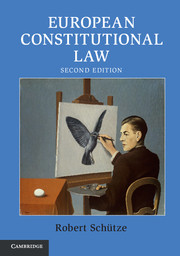Book contents
- Frontmatter
- Dedication
- Summary Contents
- Contents
- List of Illustrations
- List of Tables
- List of Cases
- List of Secondary Law
- Table of Equivalents
- List of Abbreviations
- Acknowledgements
- Introduction: European Constitutional Law
- Part I Constitutional Foundations
- 1 Constitutional History: From Paris to Lisbon
- 2 Constitutional Nature: A Federation of States
- 3 European Law I: Nature – Direct Effect
- 4 European Law II: Nature – Supremacy/Pre-emption
- 5 Governmental Structure: Union Institutions I
- 6 Governmental Structure: Union Institutions II
- Part II Governmental Powers
- Appendices
- Index
- References
3 - European Law I: Nature – Direct Effect
from Part I - Constitutional Foundations
- Frontmatter
- Dedication
- Summary Contents
- Contents
- List of Illustrations
- List of Tables
- List of Cases
- List of Secondary Law
- Table of Equivalents
- List of Abbreviations
- Acknowledgements
- Introduction: European Constitutional Law
- Part I Constitutional Foundations
- 1 Constitutional History: From Paris to Lisbon
- 2 Constitutional Nature: A Federation of States
- 3 European Law I: Nature – Direct Effect
- 4 European Law II: Nature – Supremacy/Pre-emption
- 5 Governmental Structure: Union Institutions I
- 6 Governmental Structure: Union Institutions II
- Part II Governmental Powers
- Appendices
- Index
- References
Summary
Introduction
Classic international law holds that each State can choose the relationship between its domestic law and international law. Two – constitutional – theories thereby exist: monism and dualism. Monist States make international law part of their domestic legal order. International law will here directly apply as if it were domestic law. By contrast, dualist States consider international law separate from domestic law. International law is viewed as the law between States; national law is the law within a State. While international treaties are thus binding ‘on’ States, they cannot be binding ‘in’ States. International law needs to be ‘transposed’ or ‘incorporated’ into domestic law and will thus only have indirect effects through the medium of national law. The dualist theory is therefore based on a basic division of labour: international institutions apply international law, while national institutions apply national law.
Did the European Union leave the choice between monism and dualism to its Member States? For dualist States, all European law would need to be ‘incorporated’ into national law before it could have domestic effects. Here, there is no direct applicability of European law, as all European norms are mediated through national law and individuals will consequently never come into direct contact with European law. Where a Member State violates European law, this breach can only be established and remedied at the European level. The European Treaties indeed contained such an ‘international’ remedial machinery against recalcitrant Member States in the form of enforcement actions before the Court of Justice. Another Member State or the Commission – but not individuals – could here bring an action to enforce their rights.
Did this not signal that the European Treaties were international treaties that tolerated the dualist approach? Not necessarily, for the Treaties also contained strong signals against the ‘ordinary’ international law reading of the European legal order. Not only was the Union entitled to adopt legal acts that were to be ‘directly applicable in all Member States’, but from the very beginning, the Treaties also contained a judicial mechanism that envisaged the direct application of European law by the national courts. But even if a monist view had not been intended by the founding Member States, the European Court discarded any possible dualist readings of Union law in the most important case of European law: Van Gend en Loos.
- Type
- Chapter
- Information
- European Constitutional Law , pp. 77 - 116Publisher: Cambridge University PressPrint publication year: 2015



